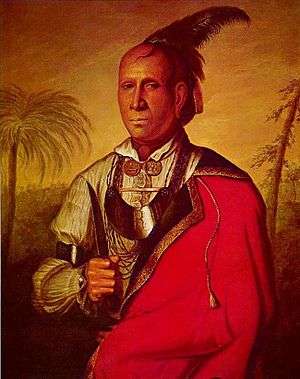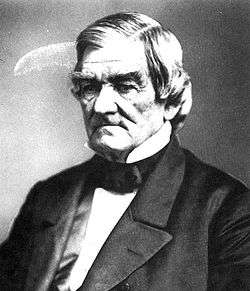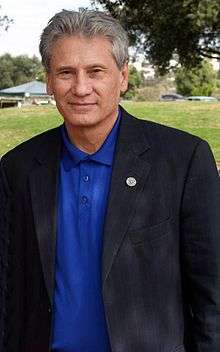Principal Chiefs of the Cherokee
Principal Chief is today the title of the chief executives of the Cherokee Nation, of the Eastern Band of Cherokee Indians, and of the United Keetoowah Band of Cherokee Indians, the three federally recognized tribes of Cherokee. In the eighteenth century, when the people were organized by clans and towns, they would appoint a leader for negotiations with the Europeans. They called him Uku, or "First Beloved Man".
The title of "Principal Chief" was created in 1794 when the Cherokee began to formalize a centralized political structure, forming the original Cherokee Nation. The Cherokee Nation–East adopted a written constitution in 1827, creating a government with three branches: legislative, executive, and judicial. The Principal Chief was elected by the National Council, which was the legislature of the Nation. The Cherokee Nation–West adopted a similar constitution in 1833. The reunited nation adopted one constitution in 1839. In 1868, the Eastern Band created a separate and distinct constitution and formalized the position of Principal Chief. The position had existed in the east since the time of Yonaguska.
In 1906, the US government dismantled the Cherokee Nation's governmental structure under the Dawes Act (except for allowing the tribe to retain limited authority to deal with remaining land issues, which lasted until June 1914).[1] Following passage of the federal Indian Reorganization Act of 1934 and the Oklahoma Indian Welfare Act of 1936, the Keetoowah Nighthawk Society organized in 1939 as the United Keetoowah Band. The Bureau of Indian Affairs approved their constitution in 1940.
The president began appointing a Principal Chief for the non-UKB Cherokee in 1941. In 1975, these Cherokee drafted their constitution as the Cherokee Nation of Oklahoma, which was ratified on June 26, 1976.[2] In 1999, they approved several changes to the constitution, including the removal of the qualifying phrase "of Oklahoma" from their name, leaving it simply "Cherokee Nation".
Early leaders

Before 1794, the Cherokee had no standing national government. Their structure was based on clans and towns, which had various leaders. The clans had functions within each town and the tribe. The towns appointed some leaders to represent the tribe to British, French, and (later) American authorities. The range of aboriginal titles were usually translated into English as "chief." The term "emperor" is placed in quotes, since this title was created by Sir Alexander Cuming and was not accepted by the tribe as a whole.[4]
- Outacite (d. 1729), peace chief, signed a 1720 treaty with Governor Nicholson, outacite is actually his title[5]
- Charitey Hagey of Tugaloo (1716–1721)
- Long Warrior of Tanasi (1729–1730)
- Wrosetasetow, "emperor" of the Cherokees until 1730;[4] real title was Ama-edohi or "water-goer",[6] served as a trade commissioner[7]
- Moytoy of Tellico (also known as Ama-edohi);[4] (d. 1741),[8] declared "emperor" by the British from 1730[9] until 1741,[7] real title was Ama-edohi or "water-goer"[6]
- Attakullakulla (or "Little Carpenter", Ada-gal'kala, Attacullaculla, Oukou-naka)[5] (1708/1711[9]–1780[10]), white peace chief from Echota[5] recognized as primary chief by the British,[11] or "president of the nation" from 1762 to 1778[7]
- Amouskositte (or Ammouskossittee, Amascossite, Ammonscossittee, Amosgasite, "Dreadfulwater")[8] of Great Tellico (b. ca. 1728), served as "emperor" from 1741–1753,[8] son of Moytoy
- Old Hop (or Guhna-gadoga,[11] Kanagatucko, and "Standing Turkey")[11](1753–1756),[11] war chief from Echota; either Ammouskossitte's uncle[7] or father.[5]
- Moytoy of Citico (or Amo-adaw-ehi), war chief during the Anglo-Cherokee War (1759–1761), nephew of the Moytoy of Tellico.[5]
- Uka Ulah (also Ukah Ulah)[7] (d. 1761), "emperor;" nephew of Old Hop,[11]
- Stalking Turkey (or Cunne Shote), traveled to England in 1762 with Henry Timberlake[3][12]
- Outacite of Keowee (ca. 1703–ca. 1780) (also known as "Judd's Friend",[5] Outacity, Outassite, Outacite, Outassatah, Wootasite, Wrosetasetow,[13] Ostenaco, Outassete,[14] Scyacust Ukah) traveled to England in 1762 with Henry Timberlake[15] chief
- Oconostota (also known as Ogan'sto', "Groundhog Sausage") (1712–1781), red war chief of Echota,[16] served entire tribe from 1778–1785,[7]
- Savanukah of Chota (1781–1783)
- Old Tassel (or "Corntassel," "Tassel," Kaiyatahee) (d. 1788),[5] peace chief from Echota,[5] served from 1783–1788[7]
- Raven of Chota (or Colonah), war chief; nephew of Oconostota[5]
- Little Turkey, served from 1788–1794[7]
- opposed by Hanging Maw (or Scolaguta),[5] served 1788–1794
Chickamauga/Lower Cherokee (1777–1809)
In 1777, Dragging Canoe and a large body of Cherokee separated themselves from the tribes which had signed treaties of peace with the Americans during the American Revolution. They migrated first to the Chickamauga (now Chattanooga, Tennessee) region, then to the "Five Lower Towns" area—further west and southwest of there—in order to continue fighting (see Cherokee–American wars). In time, these Chickamauga Cherokee became a majority of the nation, due to both sympathy with their cause and the destruction of the homes of the other Cherokee who later joined them. The separation ended at a reunification council with the Cherokee Nation in 1809.
Chiefs:
- Dragging Canoe (1777–1792)
- John Watts (1792–1802)
- Doublehead, brother of Old Tassel,[5] served from 1802–1807
- The Glass, or Ta'gwadihi (1807–1809)
Cherokee Nation East (1794–1839)

Little Turkey was elected First Beloved Man of the Cherokee (the council seat of which was shifted south to Ustanali near what is now Calhoun, Georgia) in the aftermath of the assassination by frontiersmen of Corntassel (also called Cornsilk) and several other leaders. Hanging Maw of Coyatee, listed above, claimed the title as his right by tradition, as he was the headman of the Upper Towns. Many Cherokee and the US government recognized him as Principal Chief. Little Turkey was finally recognized as "Principal Chief of the Cherokee Nation" by all the towns after the end of the Cherokee–American wars, when the Cherokee established their first nominal national government.
- Little Turkey (1794–1801)
- Black Fox (1801–1811)
- Pathkiller (1811–1827)
- Big Tiger (1824–1828); self-proclaimed chief of the faction of those in the Nation following Whitepath's teachings (which were inspired by the Seneca prophet Handsome Lake).
- Charles R. Hicks (1827), de facto head of government from 1813
- William Hicks (1827–1828)
- John Ross (1828–1839)
- William Hicks (1833–1835), elected principal chief of the faction supporting emigration to the west.
Cherokee Nation West (1810–1839)
Originally along the St. Francis and White Rivers in what was first Spanish Louisiana and later Arkansas Territory, the Western Cherokee eventually migrated to Indian Territory after the Treaty of Washington in 1828. They named their capital there Tahlontiskee. John Jolly died while the Latecomers were arriving and John Looney succeeded automatically. Looney was deposed by the council and replaced with Brown with a view toward putting the Cherokee Nation West in a better position vis-a-vis the Ross party. After the murders of Major Ridge, John Ridge, and Elias Boudinot (Treaty party members who supported the Old Settlers) in June 1839, the council had a change of heart about resisting Ross' autocratic demands and deposed Brown, replacing him with Looney. A sizable faction of the Old Settlers refused to recognize Looney and elected Rogers in his stead, but their efforts to maintain autonomy petered out the next year.
- The Bowl (1810–1813)
- Degadoga (1813–1817)
- Tahlonteeskee (1817–1819)
- John Jolly (1819–1838)
- John Looney (1838–1839)
- John Brown (1839)
- John Looney (1839)
- John Rogers (1839–1840)
Eastern Band of Cherokee Indians (1824–present)

The Eastern Band of Cherokee Indians is made up of descendants of Cherokee from along the Oconaluftee River in western North Carolina, in today's Cherokee County. The band formed after the treaties of 1817 and 1819 were made between the Cherokee Nation East and the US government; they were outside the former territory. They were later joined by Utsala's band from the Nantahala River in western North Carolina, and those few from the Valley Towns who managed to remain in 1838 following Indian Removal of most of the Cherokee to Indian Territory.
- Yonaguska (1824–1839)
- William Holland Thomas (1838–1869), European American adopted by the band
- Salonitah, or Flying Squirrel (1870–1875)
- Lloyd R. Welch (1875–1880)
- Nimrod Jarrett Smith (1880–1891)
- Stillwell Saunooke (1891–1895)
- Andy Standing Deer (1895–1899)
- Jesse Reed (1899–1903)
- Bird Saloloneeta, or Young Squirrel (1903–1907)
- John Goins Welch (1907–1911)
- Joseph A. Saunooke (1911–1915)
- David Blythe (1915–1919)
- Joseph A. Saunooke (1919–1923)
- Sampson Owl (1923–1927)
- John A. Tahquette (1927–1931)
- Jarret Blythe (1931–1947)
- Henry Bradley (1947–1951)
- Jarret Blythe (1955–1959)
- Osley Bird Saunooke (1951–1955)
- Jarret Blythe (1955–1959)
- Olsey Bird Saunooke (1959–1963)
- Jarret Blythe (1963–1967)
- Walter Jackson (1967–1971)
- Noah Powell (1971–1973)
- John A. Crowe (1973–1983)
- Robert S. Youngdeer (1983–1987)
- Jonathan L. Taylor (1987–1995)
- Gerard Parker (1995)
- Joyce Dugan (1995–1999)
- Leon Jones (1999–2003)
- Michell Hicks (2003–2015)
- Patrick Lambert (2015-current)
Cherokee Nation in Indian Territory (1839–1907)

After removal to the Indian Territory, on the Trail of Tears, a new constitution was put into place, unifying the former Eastern Cherokee with the Western Cherokee, which allowed for direct election of the Principal Chief. Though a holdout minority of the Old Settlers elected John Rogers as their principal chief, his government never gained any further support and soon faded away. The Ross faction also abandoned the established capital of Tahlontiskee and built Tahlequah instead. During the Civil War, the Nation voted to support the Confederacy, and Ross acquiesced for a time. In 1862, however, he and many of his supporters fled to Washington, upon which Stand Watie was elected Principal Chief by a majority of the Nation. The remaining Ross group never supported Watie's election, though, and lived apart under their own officials.
- John Ross (1839–1862)
- Thomas Pegg, acting principal chief of the Union Cherokee (1862–1863)
- Smith Christie, acting principal chief of the Union Cherokee (1863)
- Lewis Downing, acting principal chief of the Union Cherokee (1864–1866)
- Stand Watie, (1862–1866)
- John Ross (1866)
- William P. Ross (1866–1867)
- Lewis Downing (1867–1872)
- William P. Ross (1872–1875)
- Charles Thompson (1875–1879)
- Dennis Bushyhead (1879–1887)
- Joel B. Mayes (1887–1891)
- C. J. Harris (1891–1895)
- Samuel Houston Mayes (1895–1899)
- Thomas Buffington (1899–1903)
- William Rogers (1903–1905); deposed by the council
- Frank J. Boudinot (1905–1906); also president of the Keetoowah Nighthawk Society
- William Charles Rogers (1906)
United Keetoowah Band of Cherokee Indians (1939–present)
The UKB Cherokee are descendants primarily of Old Settlers who organized under the federal Indian Reorganization Act of 1934 and the state Oklahoma Indian Welfare Act of 1936. They ratified their constitution and bylaws and were recognized by the federal government in 1950.
- John Hitcher (1939–1946)
- Jim Pickup (1946–1954)
- Jeff Tindle (1954–1960)
- Jim Pickup (1960–1967)
- William Glory (1967–1979)
- James L. Gordon (1979–1983)
- John Hair (1983–1991)
- John Ross (1991–1995)
- Jim Henson (1996–2000)
- Dallas Proctor 2000 – 2004
- George Wickliffe 2005 – 2016
- Joe Bunch 2016 – Present
Cherokee Nation of Oklahoma/Cherokee Nation (1907–Present)


In preparation for Oklahoma statehood, the original Cherokee Nation's governmental authority was dismantled by the United States in 1906, except for limited authority to deal with land issues until 1914,[1] and the office of Principal Chief was appointed by the US federal government. In 1971 an election was held. Principal Chief and incumbent, W.W. Keeler, who had been appointed by President Harry Truman in 1949, was elected. The constitution of the Cherokee Nation of Oklahoma was drafted in 1975 and ratified on 26 June 1976.[2] A new constitution was ratified in 2003 with the name of the tribe changed to simply "Cherokee Nation".[17]
Appointed
Appointed "Principal Chiefs", many holding the title for only a single day, signed documents and performed other pro forma duties as required by the federal government.
- William C. Rogers (1907-1917)
- With the admission of Oklahoma to the Union as the forty-sixth state and to terminate any unfinished business of the tribe, an Act of April 26, 1906 (34 Statutes at Large, 148) continued the tribal governments and retained the principal chiefs and governors then in office. Under provisions of this act Rogers continued in office to sign the deeds transferring the lands of the Cherokee Nation to the individual allottees. Upon his death on November 8, 1917 the President of the United States was authorized by this act to appoint Rogers' successor.
- Charles J. Hunt (December 27, 1928)
- Oliver P. Brewer (May 26, 1931)
- William W. Hastings (January 22, 1936)
- J.B. Milam (1941–1949)
- W.W. Keeler (1949–1971)
Elected
- W.W. Keeler (1971–1975)
- Ross Swimmer (1975–1985)
- Wilma Mankiller (1985–1995)
- Joe Byrd (1995–1999)
- Chad "Corntassel" Smith (1999–2011)
- S. Joe Crittenden (acting, 2011)
- Bill John Baker (2011—present)[18]
See also
Notes
- 1 2 Conley, p. 198
- 1 2 "Constitution of the Cherokee Nation of Oklahoma." University of Oklahoma Law Center. (retrieved 16 Jan 2010)
- 1 2 Morand et al 28
- 1 2 3 Conley 16
- 1 2 3 4 5 6 7 8 9 10 11 Brown, John P. "Eastern Cherokee Chiefs." Chronicles of Oklahoma. Vol. 16, No. 1. March 1938. Retrieved 1 Jan 2013.
- 1 2 Conley 17
- 1 2 3 4 5 6 7 8 Conley 57
- 1 2 3 Conley 18
- 1 2 Timberlake and King xvii
- ↑ Fowler xiii
- 1 2 3 4 5 Conley 168
- ↑ Conley 222
- ↑ Conley 172
- ↑ Conley 171
- ↑ Morand et al 29
- ↑ Conley, "Encyclopedia," 168-9
- ↑ The 1999 Constitution Cherokee Nation. Cherokee Nation. . Retrieved 21 September 2009.
- ↑ Jouzapavicius, Justin. "Cherokee Nation: Challenger wins chief election." Associated Press. 11 Oct 2011 (retrieved 12 Oct 2011)
Sources
- Brown, John P. Old Frontiers. Kingsport: Southern Publishers, 1938.
- Conley, Robert J. The Cherokee Nation: A History. Albuquerque: University of New Mexico Press, 2008.
- Conley, Robert J. A Cherokee Encyclopedia. Albuquerque: University of New Mexico Press, 2007. ISBN 978-0826339515.
- Hoig, Stanley. The Cherokees and Their Chiefs: In the Wake of Empire. Fayetteville: University of Arkansas Press, 1998.
- McLoughlin, William G. Cherokee Renascence in the New Republic. Princeton: Princeton University Press, 1992.
- Mooney, James. Myths of the Cherokee and Sacred Formulas of the Cherokee. Nashville: Charles and Randy Elder-Booksellers, 1982.
- Moore, John Trotwood and Austin P. Foster. Tennessee, The Volunteer State, 1769–1923, Vol. 1. Chicago: S. J. Clarke Publishing Co., 1923.
- Morand, Anne, Kevin Smith, Daniel C. Swan, Sarah Erwin. Treasures of Gilcrease: Selections from the Permanent Collection. Norman: University of Oklahoma Press, 2005. ISBN 978-0-8061-9956-6.
- Timberlake, Henry and Duane King. The Memoirs of Lt. Henry Timberlake: The Story of a Soldier, Adventurer, and Emissary to the Cherokees, 1756-1765. University of North Carolina Press, 2007. ISBN 978-0807831267.
- Wilkins, Thurman. Cherokee Tragedy: The Ridge Family and the Decimation of a People. New York: Macmillan Company, 1970.